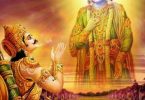Question: BG 7.4 last paragraph of the purport: “The false ego—I am,” and “It is mine,” which constitute the basic principle of material existence—includes ten sense organs for material activities. Intelligence refers to the total material creation, called the mahat-tattva. Therefore from the eight separated energies of the Lord are manifest the twenty-four elements of the material world.”
Question 1: How do you explain this sentence: “Intelligence refers to the total material creation, called the mahat-tattva.”
Answer to Question 1 by Romapada Swami:
Summary Answer: BG 7.4 does not list all 24 elements of material nature. Following Baladeva Vidyabhusana’s commentary on BG 7.4 and on 13.6-7, Srila Prabhupada is explaining how the list of 8 material elements mentioned here in BG 7.4 expand to 24 (Note: SP explicitly writes in the last paragraph of the above-quoted purport “Therefore from the eight separated energies of the Lord are manifest the twenty-four elements of the material world”). This requires establishing a connection or relationship between the 8 principal divisions of material energy, and the 24 elements of Sankhya.
Below are perspectives on how those connections are detailed.
Perspective #1
Baladeva Vidyabhusana’s commentary to BG 7.4 reads:
“The mention of earth, water, fire, air, and ether includes their respective sense objects, which are their causes—smell, taste, form, touch, and sound. False ego includes its effects, the eleven senses: mind, nose, tongue, eye, skin, ear, hands, feet, voice, anus and genital. Buddhi here refers to the mahat-tattva. Manas (usually meaning mind) here refers to the pradhāna, the unmanifest stage of prakṛti (avyaktam), which is understood through the mind (but not perceived by the senses, since it is unmanifest). The śruti says: caturviṁśati-saṅkhyānām avyaktaṁ vyaktam ucyate. Avyakam is clearly mentioned as belonging to the twenty-four elements. Mantrika Upaniṣad 15 The Lord will Himself explain the complete list in chapter thirteen when describing the field: mahā-bhūtāny ahaṅkāro buddhir avyaktam eva ca indriyāṇi daśaikaṁ ca pañca cendriya-gocarāḥ The field consists of the five great elements, false ego, mahat-tattva, the unmanifest, the ten senses, the mind, and the five sense objects.”
Srila Baladeva Vidyabhusana’s explanation here refers the reader to the 13th chapter of BG for further details. In his explanation to BG 13.6-7, Baladeva writes “Buddhi means mahat-tattva, predominated by jnana, which is ahankara’s cause.” <see Footnote 1 below> In fact, all the 23 elements of prakriti are related to the 24th element, mahat-tattva, because they all emanate from it. Baladeva clearly declares that “mahat-tattva, predominated by jnana” is Buddhi. Thus, when Srila Prabhupada writes in his BG 7.4 purport “Buddhi here refers to the mahat-tattva,” it is to be understood as buddhi pointing to mahat-tattva as its cause; it doesn’t mean buddhi is literally equal to or same as mahat-tattva.
Conclusion: Of the 8 material elements mentioned in BG 7.4, Buddhi has been linked to the mahat-tattva (the 24th element) using the above-mentioned source-and-byproduct relation. Note: Further on in Baladeva Vidyabhusana’s commentary to BG 7.4, he also mentions the source-and-byproduct or “cause-effect” relation between ahankara and the 10 senses.
Perspective #2
The mind is a collection of undifferentiated thoughts etc., but it needs intelligence to distinguish and differentiate. Pradhana, like the collection of undifferentiated thoughts within the mind, is full of undifferentiated elements and three modes. Mahat-tattva is like the intelligence because it can differentiate the three modes and then the elements. In fact, Mahat-tattva is often called “tamas-buddhi” and manifests a kind of intelligence.
Sridhar Swami’s commentary on BG 7.4 confirms this: “manas is the pradhāna in unmanifest form”
~~~
Here is a follow-up Question, based on Srila Baladeva Vidyabhusana’s above-cited BG 7.4 commentary.
Question 2: How to understand Baladeva’s statement regarding “the mind refers to the pradhana”? Yes, the subtle mind is required to understand the unmanifest, but equating the two is not clear.
Answer to Question 2 by Romapada Swami:
The Sanskrit word manas does not literally mean pradhāna. Alternatively, then, similar to the “buddhi –> mahat-tattva relation” understanding, it seems the statement “the mind refers to the pradhana” is likewise not meant to imply equality, but is similarly meant to be a relational statement.
Here is an additional point: BG 13.6-7 declares “mahā-bhūtāny ahaṅkāro buddhir avyaktam eva ca.” Srila Baladeva Vidyabhusana connects avyaktam (unmanifest) with pradhana. Since the subtle mind is required to understand the unmanifest (the senses cannot access it), the relation between mind and the unmanifest (pradhana) is drawn.
Footnote 1: Pradhāna, being inert, does not require intelligent guidance. The mahat-tattva, however, is the activated material energy, activated by the time energy and the residual karma of souls who are projected into it by the Lord’s glance. In this way, material nature in its mahat-tattva state, is functioning with cosmic intelligence.
Pradhana is inert and cannot function on its own, but when the Lord impregnates it with jivas and time, it takes on an active consciousness, which then becomes mahat-tattva with intelligence. [Note: this is very similar to Baladeva’s commentary on BG 13.6-7, where he writes “Buddhi means mahat-tattva, predominated by jnana, which is ahankara’s cause.”]
In fact, an entirely different perspective on this topic of the 8 essential elements of creation is to consider the elements mentioned in BG 7.4 to be the “protype elements” in their Virat Rupa state, prior to the perceivable cosmic manifestation.
In SB 3.6.26 it is mentioned that the Maha-tattva is the consciousness of the Virat Purusa. “Thereafter, when the consciousness of the gigantic form separately manifested itself, the total energy, the mahat-tattva, entered with the gigantic form’s conscious part. Thus the living entity is able to conceive specific knowledge.”
In SB 3.26.19-20 it is explained that the Maha-tattva is the source of Hiranmaya (cosmic intelligence).
In SB 3.5.27, Srila Prabhupada writes in his purport, ‘The mahat-tattva is the total consciousness because a portion of it is represented in everyone as the intellect. The mahat-tattva is directly connected with the supreme consciousness of the Supreme Being, but still, it appears as matter.’
INTERESTING: Please refer to SB 11.22.1-9, where Uddhava asks Krishna why different sages calculate a different number of material elements: 26, 25, 7, 9, 6, 4, 11, 17, 16, and 13.
Krishna replies basically that they can all be right by His mystic power (not maha-maya):
“Because all material elements are present everywhere [santi sarvatra], it is reasonable that different learned brahmanas have analyzed them in different ways. All such philosophers spoke under the shelter of My mystic potency [maya], and thus they could say anything without contradicting the truth. O best among men, because subtle and gross elements mutually enter into one another, philosophers may calculate the number of basic material elements in different ways, according to their personal desire. All subtle material elements are actually present within their gross effects; similarly, all gross elements are present within their subtle causes, since material creation takes place by progressive manifestation of elements from subtle to gross. Thus we can find all material elements within any single element.” (SB. 11.22.7–8)
Text 9: Therefore . . .
Krishna concludes: “Therefore, no matter which of these thinkers is speaking, and regardless of whether in their calculations they include material elements within their previous subtle causes or else within their subsequent manifest products, I accept their conclusions as authoritative, because a logical explanation can always be given for each of the different theories.” (SB. 11.22.9)
Conclusion: We can look at the elements in different ways without those ways being wrong.







